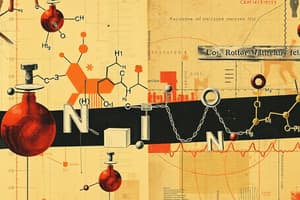Podcast
Questions and Answers
What is the primary function of catabolic pathways in metabolism?
What is the primary function of catabolic pathways in metabolism?
- To break down complex molecules and release energy (correct)
- To synthesize complex molecules from simple molecules
- To facilitate oxidation reactions alone
- To store energy in the form of ATP
Which of the following accurately describes a redox reaction?
Which of the following accurately describes a redox reaction?
- Always results in the formation of ATP
- Only occurs in the mitochondria
- Involves the transfer of electrons between species (correct)
- Involves only the loss of oxygen
What is produced from the hydrolysis of ATP?
What is produced from the hydrolysis of ATP?
- Only ADP and water
- ADP, Pi, and protons (H+) (correct)
- ADP and GTP
- AMP and inorganic phosphate (Pi)
Where does glycolysis occur within a cell?
Where does glycolysis occur within a cell?
What role does phosphofructokinase play in glycolysis?
What role does phosphofructokinase play in glycolysis?
What is the energy currency in living cells and what is its primary source of energy?
What is the energy currency in living cells and what is its primary source of energy?
What happens if a system is left without an input of energy?
What happens if a system is left without an input of energy?
Which of the following statements about anabolic pathways is true?
Which of the following statements about anabolic pathways is true?
What is the final product of glycolysis?
What is the final product of glycolysis?
Which molecule is regenerated by the reduction of pyruvate to lactate during anaerobic conditions?
Which molecule is regenerated by the reduction of pyruvate to lactate during anaerobic conditions?
What is the net ATP production during glycolysis?
What is the net ATP production during glycolysis?
What activates the pyruvate dehydrogenase enzyme complex?
What activates the pyruvate dehydrogenase enzyme complex?
Which metabolic pathway occurs in the mitochondrial matrix?
Which metabolic pathway occurs in the mitochondrial matrix?
How many NADH molecules are produced in glycolysis?
How many NADH molecules are produced in glycolysis?
What is the primary purpose of gluconeogenesis in the liver after intense exercise?
What is the primary purpose of gluconeogenesis in the liver after intense exercise?
Which enzyme is primarily responsible for converting pyruvate to acetyl-CoA?
Which enzyme is primarily responsible for converting pyruvate to acetyl-CoA?
What is the overall equation representing gluconeogenesis?
What is the overall equation representing gluconeogenesis?
What happens to acetyl-CoA excess in the liver?
What happens to acetyl-CoA excess in the liver?
Flashcards
What is metabolism?
What is metabolism?
The sum of all chemical reactions occurring within a living organism, essential for maintaining life.
What are catabolic pathways?
What are catabolic pathways?
Metabolic pathways that break down complex molecules into simpler ones, releasing energy in the process.
What are anabolic pathways?
What are anabolic pathways?
Metabolic pathways that build complex molecules from simpler ones, requiring energy from ATP.
What is phosphorylation?
What is phosphorylation?
Signup and view all the flashcards
What is oxidation?
What is oxidation?
Signup and view all the flashcards
What is reduction?
What is reduction?
Signup and view all the flashcards
What is ATP?
What is ATP?
Signup and view all the flashcards
What is glycolysis?
What is glycolysis?
Signup and view all the flashcards
What is the first step in glycolysis?
What is the first step in glycolysis?
Signup and view all the flashcards
How is DAP converted to GA-3-P?
How is DAP converted to GA-3-P?
Signup and view all the flashcards
What happens to GA-3-P after it's formed?
What happens to GA-3-P after it's formed?
Signup and view all the flashcards
What is the final product of glycolysis?
What is the final product of glycolysis?
Signup and view all the flashcards
What is the net energy yield of glycolysis?
What is the net energy yield of glycolysis?
Signup and view all the flashcards
What happens to pyruvate in anaerobic conditions?
What happens to pyruvate in anaerobic conditions?
Signup and view all the flashcards
What causes muscle pain during intense exercise?
What causes muscle pain during intense exercise?
Signup and view all the flashcards
What is the Cori cycle?
What is the Cori cycle?
Signup and view all the flashcards
What is the process of converting pyruvate to glucose called?
What is the process of converting pyruvate to glucose called?
Signup and view all the flashcards
What happens to pyruvate in the mitochondrial matrix?
What happens to pyruvate in the mitochondrial matrix?
Signup and view all the flashcards
Study Notes
Metabolism Overview
- Metabolism encompasses all chemical processes in a living organism for life maintenance.
- Metabolic pathways involve reactants, products, and enzymes.
- Metabolism can be categorized as catabolic (breaking down complex molecules) and anabolic (building complex molecules).
- Specific pathways occur in specific locations, like glycolysis in the cytosol and the TCA cycle in the mitochondrial matrix.
- Glucose metabolism involves many interlinked metabolic pathways.
Reaction Types
- Hydrolysis: Breaking down molecules by adding water.
- Condensation: Joining molecules, releasing water.
- De/phosphorylation: Removal/addition of phosphate groups.
- De/carboxylation: Removal/addition of CO2.
- Oxidation: Gain of oxygen, or loss of electrons.
- Reduction: Loss of oxygen, or gain of electrons.
- Redox reactions commonly occur together, transferring electrons between species.
Energy in Cells
- Systems without energy input reach thermodynamic equilibrium (death).
- Cells store energy as fat or glycogen.
- ATP (adenosine triphosphate) is the energy currency of cells.
- ATP's high-energy phosphate bonds release energy via hydrolysis (adding water).
- ATP production occurs via oxidative phosphorylation or substrate-level phosphorylation.
Energy Generation (Respiration)
Glycolysis
- Occurs in the cytosol.
- Glucose is phosphorylated, priming the molecule, using 2 ATPs.
- The 6-carbon molecule is split to two 3-carbon molecules (glyceraldehyde-3-phosphate).
- These are further modified, releasing energy to produce 4 ATPs and 2 NADHs.
- Net product: 2 ATPs and 2 NADHs from 1 glucose molecule.
Anaerobic Conditions
- Without oxygen, NAD+ regeneration cannot occur via oxidative phosphorylation.
- Cells convert pyruvate to lactate, oxidizing NADH to NAD+.
- Lactate buildup causes muscle pain; it's transported to liver cells.
- The Cori cycle converts lactate back to glucose.
- This cycle consumes significant ATP.
Oxidative Decarboxylation
- Occurs in the mitochondrial matrix.
- Pyruvate is converted to acetyl-CoA, releasing NADH and CO2.
- Pyruvate dehydrogenase can be regulated by phosphorylation (inhibited) or dephosphorylation (activated).
- Other molecules, like amino acids and fatty acids, can also be converted to acetyl-CoA.
Studying That Suits You
Use AI to generate personalized quizzes and flashcards to suit your learning preferences.




